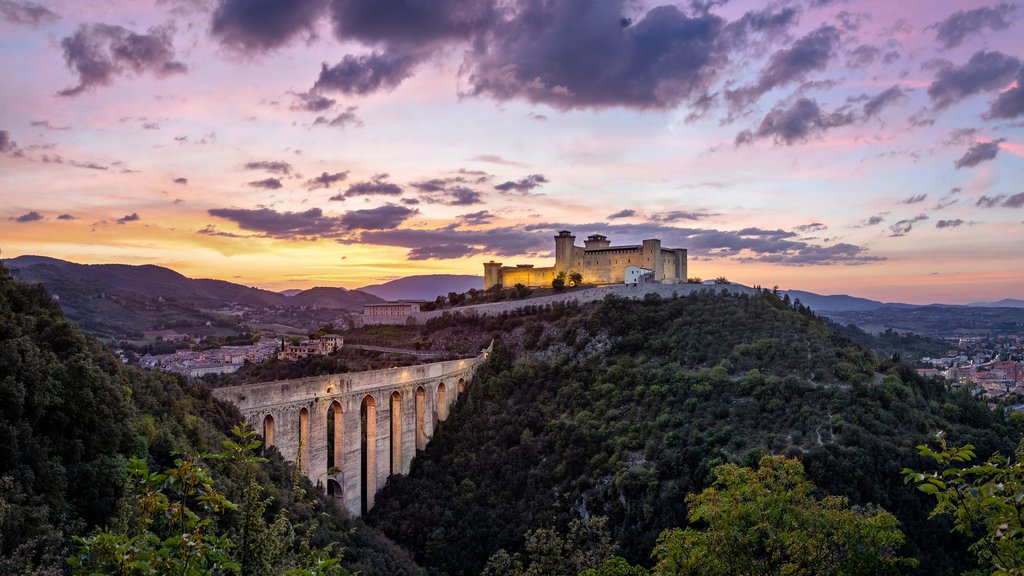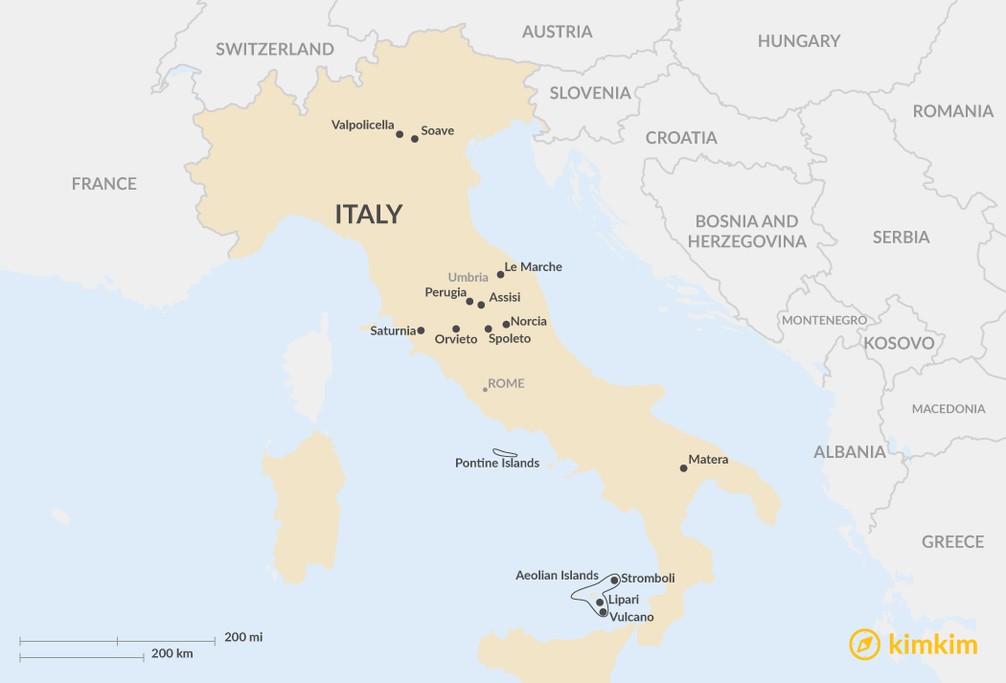
So you’ve ticked off the Colosseum in Rome, boated the canals in Venice, and have come back for more. Bravo, as the Italians would say—there is a lot more to this country than the trophy sights, and enough little-known treasures to fill a lifetime of repeat visits. Get to know the Aeolian Islands, Saturnia, the hill towns of Umbria, and more.
## Discovering the Authentic Soul of Italy: Beyond the Tourist Trail
To truly understand Italy, to feel its pulse and breathe in its essence, one must venture beyond the well-trodden paths. Escape the throngs of tourists and, instead, embrace the spirit of the Italian people by seeking out the hidden gems, the secluded beaches, the tranquil islands, and the charming hill towns that remain largely undiscovered by the masses. Trust us; you won’t regret taking this leap into the authentic heart of Italy. Let us guide you to five extraordinary destinations where you can experience the true magic of this captivating country.
## The Enchanting Aeolian Islands
Imagine stepping onto a string of volcanic jewels scattered off Italy’s southernmost coast, a mere stone’s throw from the shores of northern Sicily. These are the Aeolian Islands, a secret haven still relatively unknown to many travelers. Yet, these islands pulse with an energy that is both ancient and vibrant. Here, you can immerse yourself in a world of crystalline waters perfect for swimming, snorkeling, diving, kayaking, and sailing. Alternatively, you can embark on invigorating hikes that lead to smoldering craters and otherworldly fumaroles. Picture yourself relaxing on black-sand beaches, gazing out at breathtaking sea views painted with the colors of peachy sunsets. A sense of tranquility and easy-going charm permeates every corner of these islands. Named after Aeolus, the mythical god of winds, the Aeolian Islands are steeped in rich mythology, playing a significant role in Homer’s epic poem, the *Odyssey*. Their unique geological and cultural significance was recognized in 2000 when UNESCO bestowed upon them the prestigious title of World Heritage Site.
But where does one begin their Aeolian adventure? Your journey will likely commence upon arrival by hydrofoil from Sicily (specifically, Milazzo) or via ferry from the vibrant city of Naples. Both routes will lead you to the main port of **Lipari**, the largest of the islands. Here, you’ll find a captivating clifftop citadel, the Castello, beckoning you to explore its ancient walls and hidden corners. Within Lipari’s archaeological museum lies one of Italy’s most treasured collections, a stunning array of Neolithic, Bronze Age, and Greco-Roman artifacts that offer a fascinating glimpse into the islands’ rich history.
From Lipari, the other islands are easily accessible. A short hop takes you to **Vulcano**, an island of therapeutic mud baths and invigorating hot springs. It is also home to lush vineyards and challenging volcano hikes. For a truly dramatic experience, venture to the lava-blackened island of **Stromboli**. There, you can embark on a guided trek to the crater of its active volcano and witness the awe-inspiring spectacle of nighttime eruptions, a truly unforgettable sight. If relaxation is your priority, head to the greener island of **Salina**, known for its laid-back lifestyle and its picturesque, cliff-backed bays such as **Pollara**, the stunning location featured in the beloved 1994 film, *Il Postino*. For a touch of glamour and high-society fun, join the party-loving jet set on the sophisticated island of **Panarea**. For a truly remote and old-fashioned experience, journey to **Alicudi**, an island where time seems to stand still, and where cars are replaced by the gentle rhythm of mule tracks.
## Unveiling the Thermal Delights of Saturnia
Venture off the beaten path and drive through the rolling hills of the **Maremma**, a region of southern Tuscany that often goes unnoticed by tourists. As you meander through chestnut forests, across marshlands, and past charming medieval hamlets, prepare to be amazed. Suddenly, the landscape transforms, giving way to the mesmerizing phosphorescent blue waters of Saturnia. These thermal baths, naturally enriched with minerals and sulfur, have been revered for their remarkable health benefits since the times of the Etruscans and Romans. The water maintains a consistently warm temperature of 99.5°F throughout the year, making it an inviting destination regardless of the season.
For a luxurious experience, indulge in the **Terme di Saturnia** spa, where you can immerse yourself in the soothing waters to your heart’s content. You can also treat yourself to detoxifying treatments, such as thermal mud wraps, designed to rejuvenate your body and soul. Alternatively, follow the example of the locals and head to the free waterfalls at **Cascate di Mulino**. Here, you can bathe in the natural pools, surrounded by the beauty of the Tuscan countryside. Remember to wear your swimsuit as there are no changing facilities available, and don’t forget to bring your own towel. While the water may have a slightly eggy smell, rest assured that this is simply the sulfur doing its work, providing you with its therapeutic benefits.
## Discovering the Hill Towns of Umbria
While Tuscany often steals the spotlight, the region of Umbria boasts an equal, if not superior, collection of charming hill towns. Each town is a maze of winding alleys, historic centers crafted from honey-colored stone, and a lifestyle that revolves around the simple pleasures of life. Enjoy a morning cappuccino in a local cafe, savor a delightful evening *aperitivo*, or partake in the ritual *passeggiata*, a leisurely stroll, on the cathedral-topped piazza. Beyond the towns, the landscape is just as breathtaking, adorned with vineyards, olive groves, and mountains that rival those of its western neighbor.
A perfect starting point for your Umbrian adventure is **Perugia**, the regional capital. Discover its ancient Etruscan walls, its immaculately preserved medieval center, and the exquisite Perugino frescoes that adorn its Gothic Palazzo dei Priori. Perugia is also home to one of Italy’s oldest universities, dating back to the 14th century. From Perugia, embark on a pilgrimage to the saintly town of **Assisi**, home to the magnificent UNESCO-listed Basilica di San Francesco. Other enchanting hill towns worth exploring include **Spoleto**, with its imposing medieval fortress and stunning mountain backdrop; **Norcia**, a foodie paradise renowned for its truffles and cured meats; and **Orvieto**, where the elaborately frescoed facade of the cathedral never fails to elicit gasps of wonder.
And don’t stop there! The neighboring **Le Marche** region offers similar allure and remains equally undiscovered, promising even more opportunities for authentic Italian experiences.
## The Alluring Vineyards of Valpolicella Wine Country
Tuscany may be the first destination that comes to mind for wine lovers planning a road trip, but the wines and landscapes of Valpolicella are just as captivating, especially since the region sees fewer travelers. Valpolicella, a wine-growing region whose heritage traces back to the ancient Greeks, offers a compelling alternative. Located just a stone’s throw from Verona, this “valley of many cellars,” nestled in Italy’s northeastern **Veneto** region, benefits from a unique microclimate between the majestic Lake Garda and the imposing Alps. Slow touring is the best way to experience Valpolicella. This allows ample time for cellar tours and tastings of the area’s protected DOC wines. The best way to tour Valpolicella is to arrange a guided day trip from Verona.
Consider starting your journey in **Soave**, where medieval fortifications stand guard over hills and plains adorned with rows of vines. Here, the crisp white wine possesses a delightful peachy, round, and smooth character. However, the region is most celebrated for its bold red wines, brimming with aromas of ripe red fruit, such as Amarone, Ripasso, and Classico. Many of these wines can be sampled in the inviting ambiance of local, family-run cellars and wineries.
## The Secluded Paradise of the Pontine Islands
If Italians are reluctant to share information about these islands, located off the coast between Rome and Naples, it is because they consider them to be a well-kept secret. Internationally, the Pontine Islands are less renowned than the glamorous island of Capri further south. These islands might just be the Italy you’ve always dreamed of, with towering sea cliffs plunging into bays filled with pink coral, pebbles, and powder-soft sand. You can explore grottoes by boat or kayak, swim and dive in crystal-clear waters, and dine on freshly caught shellfish while enjoying the sea views. For an added touch of luxury, hire a private skipper to transport you between the islands at your own pace.
**Ponza** and **Ventotene** are the two inhabited islands. Both boast charming harbor towns where colorful houses cling to the cliff faces. Outside of the peak summer season (mid-June to August), the atmosphere is relaxed, and the crowds are minimal.
## Matera: A City Reborn
If Matera has escaped the limelight until now, that will soon change. Matera, a town in the Basilicata region, has been named the European Capital of Culture for 2019. What is remarkable is that Matera has remained relatively unknown for so long. This ochre-pink town, which cascades down a hillside and is topped by a magnificent *duomo* (cathedral), is one of the world’s oldest continuously inhabited settlements, with a history spanning over 7,000 years.
What makes Matera truly unique are the *sassi* (cave dwellings carved out of the soft tufa limestone), ancient frescoed churches, and crypts that honeycomb the hillsides. Much of Matera’s appeal is hidden beneath the surface. The **Cripta del Peccato Originale** (Crypt of Original Sin), a network of caves adorned with Benedictine frescoes, is one of the must-see underground locations. It can be visited on a private guided tour. To gain a better understanding of the *sassi*’s history, stop at **Casa Noha**, a multimedia exhibit located in a 16th-century home.
The cave dwellings were once associated with poverty and poor living conditions. Today, however, they have been transformed into stylish boutique hotels and minimalist-cool restaurants.

B-1406
